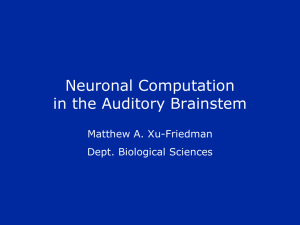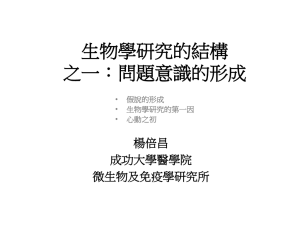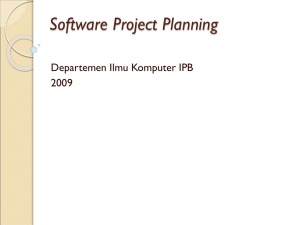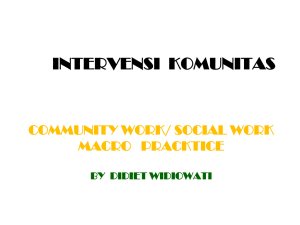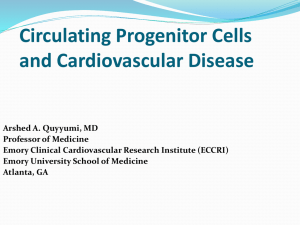adult stem cells
advertisement
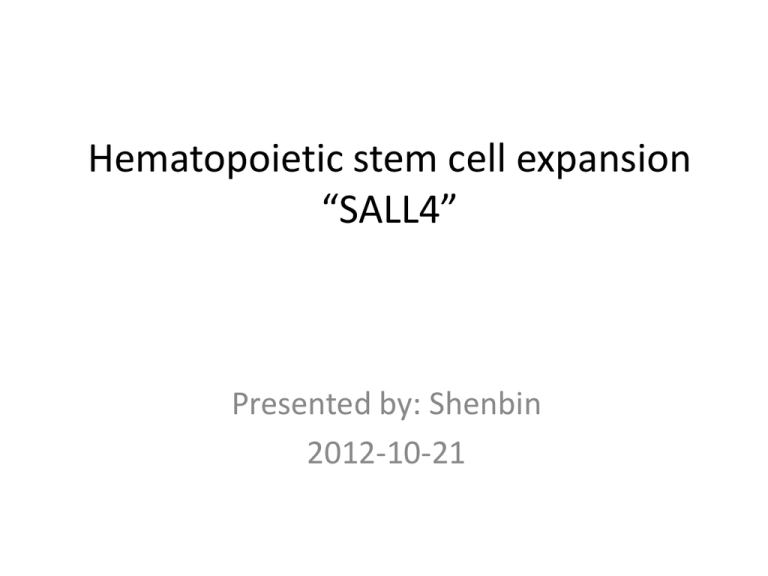
Hematopoietic stem cell expansion “SALL4” Presented by: Shenbin 2012-10-21 SpaltSALL • Spalt(sal) homeotic gene function in the head and tail region of the Drosophila embryo Ronald P.Kuhnlein, Gotz Frommer, et al. The EMBO Journal vol. 13 no. 1 pp. 168 - 179, 1994 • mutations at SALL1 on chromosome 16q12. being associated with Townes-Brocks syndrome – 耳前有附耳,皮赘,肛门闭锁、前移或形成直肠-肛门瘘 • mutations at SALL4 being shown to be causative in patients with Okihiro syndrome – 眼球后退综合征,一种先天性眼运动失调症 – 前臂畸形和耳聋,或者桡侧手畸形、眼肌运动受限 J Kohlhase, L Schubert, M Liebers et al. J Med Genet 2003;40:473–478 Research development of this field Hematopoietic stem cells • Self-renew • Capable of differentiating into all blood cell types[1] • Exist[2] – – – – – fetal bone marrow adult bone marrow peripheral blood Liver umbilical cord blood • Clinical[2] – – – – Leukemia inborn anomalies of the blood and immune system Aplastic anemia(再生障碍性贫血) Hemoglobinopathies (血红蛋白病) [1] Yang J, Aguila JR, Alipio Z, et al. J Hematol Oncol 2011; 4:38 [2] Aguila JR, Liao W, Yang J, et al. Blood 2011; 118:576–585. SALL4 • zinc-finger transcriptional factor[2] • SALL4 is one of four human homologues of the Drosophila region-specific homeotic gene spalt (sal) [3] http://en.wikipedia.org/wiki/Zinc_finger [2] Aguila JR, Liao W, Yang J, et al. Blood 2011; 118:576–585. [3] Jianchang Yangb, Wenbin Liao, et al. Curr Opin Hematol 2012, 19:287–291 Role of SALL4 in hematopoiesis Unlike many embryonic stemness factors, SALL4 is also expressed in adult stem cells, particularly hematopoietic precursor cells. Overexpression of SALL4 is able to promote the proliferation and maintain the self-renewal of (HSCs/HPCs). Epigenetic mechanisms are likely involved in SALL4’s function in regulating the stem cell fate and self-renewal of HSCs/HPCs. Dual functions of sall4 and its Regulated pathways in Hematopoiesis[3] – Suppress important differentiation genes – Activates key pluripotency genes – Interplay: • • • • • HOX family of transcription factors the polycomb group (PcG) genes components of the Wnt/b-catenin pathway the Notch signaling pathway bone morphogenic protein (BMP) family [3] Jianchang Yangb, Wenbin Liao, et al. Curr Opin Hematol 2012, 19:287–291 • SALL4 is a robust stimulator for the expansion of hematopoietic stem cells ?? In vitro lentivirus TAT-His-SALL4B Protein In vivo Murine system Nonhuman primate SALL4-Lentiviral infection of human CD34+ cells • Human bone marrow CD34+ cells – AllCells – Peripheral blood • Medium – StemSpan SFEM • StemCell Technologies – Stem Span SFEM+10%FBS+1% pen/strep(Invitrogen) – Cytokines • Flt-3: 100ng/ml • TPO: 100ng/ml • SCF: 100ng/ml • 12-well plate, 10^5 cells/well • Transduction – MOI: 10-20 – SALL4 lentivirus & GFP-control lentivirus – Infecte overnight for 12-15h Transfused with GFP lentivirus Transfused with SALL4B-GFP lentivirus Aguila JR, Liao W, Yang J, et al. Blood 2011; 118:576–585. • To see whether the sall4-transduced cells were still capable of surviving and expanding – Culture in media containing 50% less cytokines – Culture in media containing 75% less cytokines Isolated CD34+ cell from peripheral blood 7 days after transfected with sall4b lentivirus Aguila JR, Liao W, Yang J, et al. Blood 2011; 118:576–585. 75% less cytokines 50000 cells 1st day Group SALL4A and SALL4B expanded approximately 130-fold Group control cells expanded 12-fold at most Aguila JR, Liao W, Yang J, et al. Blood 2011; 118:576–585. 14 days SALL4A vs. control = 368-fold SALL4B vs. control = 384-fold Aguila JR, Liao W, Yang J, et al. Blood 2011; 118:576–585. Group SALL4A: 31 days later Group SALL4B: 31 days later Group control: 3 days later Aguila JR, Liao W, Yang J, et al. Blood 2011; 118:576–585. • 14 days of culture – Sall4-transduced cells growth and survival were independent of FLT-3L – Partially dependent of TPO – Dependent of SCF Marrow niche unlike high artificial levels in cell cultures Indicate SALL4 works in conjunction with the available cytokine levels in its environment to regulate cell expansion. [4] Yang J, Gao C, Chai L, Ma Y. PLoS One 2010; 5:e10766 TAT-SALL4B protein induced CD34+ cells expansion • TAT-6His-SALL4B – E coli – Purified by nickel-nitrilotriacetic acid agarose – 200nM, twice a day Aguila JR, Liao W, Yang J, et al. Blood 2011; 118:576–585. Culture for 3-4 days Aguila JR, Liao W, Yang J, et al. Blood 2011; 118:576–585. Murine system • mouse HSC/HPC s (Lin-, Sca-1 +, c-Kit +; LSK cells) were isolated and transduced with lentiviruses carrying either GFP alone (control), or together with Sall4A or Sall4B isoform – (100 ng/ml mSCF, 6 ng/ml mIL-3 and 10 ng/ml hIL-6) Murine system Yang J, Aguila JR, Alipio Z, et al. J Hematol Oncol 2011; 4:38 Transplantation • • • • • 10 days cell culture Cell number: 2*10^6 Donor: Ly5.2+; recipient: Ly5.1 mice Intravenously Sublethally irradiated(500 rad) The population of donor cells (Ly5.2+) in the peripheral blood of the recipient mice was examined by flow cytometry assays with the indicated antibodies at 2 weeks after BM transfusion. Peripheral blood mononuclear cells(PBMCs) Yang J, Aguila JR, Alipio Z, et al. J Hematol Oncol 2011; 4:38 The Ly5.2+ cell percentages within the peripheral white blood cells of recipients were measured at 2, 20, and 50 weeks after transplantation of indicated lentivirus-infected BM cells. Error bars represent standard error of the mean. Yang J, Aguila JR, Alipio Z, et al. J Hematol Oncol 2011; 4:38 The lineage (Gr-1, B220 and CD4/CD8) and primitive cell (Sca-1) distribution of Ly5.2+ cells was examined with the indicated antibodies for each group Yang J, Aguila JR, Alipio Z, et al. J Hematol Oncol 2011; 4:38 • Competitive repopulation assays to determine the activity of Sall4 transduced HSC/HPCs with day14 ex vivo cultured cells – Varying doses of cells baring Ly5.2 antigens were mixed with a constant number of non-transduced competitive BM cells (2*10^5, Ly5.1+), – injected into lethally irradiated (900 rad) congenic mice (Ly5.1). – 3 months Three months after transplantation, the percentage of regenerated lineages contributed from donor cells Yang J, Aguila JR, Alipio Z, et al. J Hematol Oncol 2011; 4:38 Why? • Epigenetic mechanisms involved in the regulatory functions of sall4 in hematopoietic stem/progenitor cells • SALL4-mediated activation of Bmi-1[5] – trimethylation of histone 3 lysine4 (H3K4), which is associated with gene activation • SALL4 can interact with an epigenetic repressor, Mi-2/nucleosome remodeling and deacetylase (NuRD) complex, mediating transcriptional repression[6] – PTEN, SALL4-immunocomplexes have histone deacetylase activity • SALL4 binds and actively recruits DNA methyltransferases (DNMTs), including DNMT1, DNMT3A, DNMT3B and DNMT3L, to target genes and represses their expression[7] [5] Yang J, Chai L, Liu F, et al. Bmi-1 is a target gene for SALL4 in hematopoietic and leukemic cells. Proc Natl Acad Sci U S A 2007; 104:10494–10499. [6] Lu J, Jeong H, Kong N, et al. Stem cell factor SALL4 represses the transcriptions of PTEN and SALL1 through an epigenetic repressor complex. PLoS One 2009; 4:e5577. [7] Yang J, Corsello TR, Ma Y. Stem cell gene SALL4 suppresses transcription through recruitment of DNA methyltransferases. J Biol Chem 2012; 287: 1996–2005. Up to now Purchased normal human bone marrow CD34+ cells Isolated human peripheral blood CD34+ cells Isolated mouse bone marrow hematopoietic stem/progenitor cells(Lin-/Sca-1+/c-Kit+) Isolated mouse peripheral blood HSCs Myeloid progenitor cells(32D) SALL4-GFP lentivirus transduct approach TAT-His-SALL4B protein approach Epigenetic mechanisms Prospect • Nonhuman primate system • Human system – Clinical test Expanded HSC application Red blood cells Platelet Granulocyte Liver cells Beta cell … attempt TAT-His-SALL4B protein Enucleation Mechanisms Confirmation; mechanisms; applications; Technical difficulties Thanks for your attention
